Thesis Chapters by Adrián Silva-Caballero
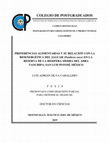
Las interacciones de los animales silvestres, como lo es la depredación, tienen consecuencias a d... more Las interacciones de los animales silvestres, como lo es la depredación, tienen consecuencias a diversos niveles de los ecosistemas, aquellas que involucran a los grandes carnívoros, llegan a generar profundas repercusiones en su composición y funcionamiento. La depredación contribuye notablemente al flujo y conservación de energía, asimismo interviene de manera importante en la regulación de poblaciones. Generalmente, el consumo de presas por parte los depredadores se ve regulado por la abundancia y disponibilidad de éstas, así como por las necesidades energéticas de los primeros. El jaguar (Panthera onca) es el felino más grande del continente y el único representante del género Panthera en América, no obstante, se considera que existe muy poca información cuantitativa sobre aspectos importantes de su ecología de poblaciones, historia de vida y patrones de actividad. En particular, respecto a la ecología alimentaria existen muchas suposiciones y conjeturas en cuanto a la obtención y uso de la energía por estos depredadores. El presente estudio analiza, mediante el uso de equipo de telemetría GPS los requerimientos energéticos de los jaguares que habitan la Reserva de la Biosfera Sierra del Abra Tanchipa. Durante 2016, se capturaron 3 individuos de P. onca, un adulto (JM01) y 2 subadultos (JM02, JH01) en dicha Reserva, los cuales fueron dotados de collares satelitales. Mediante el seguimiento exhaustivo de dichos individuos y el análisis de sus sitios de caza (n = 29) se registraron 37 presas muertas, siendo el Pecari tajacu, Bos taurus y Odocoileus virginianus las presas mayormente consumidas. Estas presas representaron un consumo total de 1,790.54 kg de biomasa por parte de los individuos monitoreados, los cuales, a su vez, tuvieron ámbitos hogareños de entre 62.05 y 440.0 km2. Con base en estos datos se construyó un modelo aditivo de los requerimientos energéticos del jaguar en la Reserva de la Biosfera Sierra del Abra Tanchipa.
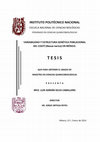
La variabilidad genética es un factor importante para la supervivencia de los individuos ya que p... more La variabilidad genética es un factor importante para la supervivencia de los individuos ya que permite a los individuos adaptarse a los cambios ambientales. A pesar de que al Nasua narica se le considera el único carnívoro verdaderamente sociable que habita en los bosques neotropicales, se sospecha que las poblaciones que habitan en Norteamérica se han aislado genéticamente de forma gradual, debido principalmente a la fragmentación y pérdida de hábitat.
Se analizaron la variabilidad y estructura genética del N. narica en cinco poblaciones de México (Parque Museo de La Venta, Parque Nacional El Tepozteco, Puerto Morelos, Punta Raza y Reserva de la Biosfera de Chamela-Cuixmala) mediante el uso de marcadores moleculares, 12 microsatélites específicos y un fragmento del gen de citocromo b. Los resultados mostraron niveles de moderados a altos en los indicadores de variabilidad genética para ambos marcadores genéticos. La heterocigosidad esperada (HE) fue de 0.664, mientras que la heterocigosidad observada (HO) fue de 0.774. La mayoría de los microsatélites se encontraron en equilibrio de Hardy-Weinberg. Todos los loci fueron polimórficos en las cinco poblaciones y el promedio de alelos por locus fue de 5.033 ± 1.794 (DE). La diversidad haplotípica (h) para las poblaciones en conjunto fue 0.968 ± 0.008 (DE) y la diversidad nucleotídica (π) de 0.007 ± 0.001 (DE).
Se registraron 22 haplotipos distintos, la mayoría fueron específicos de una de las áreas muestreadas, sólo tres se compartieron entre las distintas poblaciones. Se encontraron diferencias significativas entre las poblaciones de la Costa del Pacífico (Punta Raza y Reserva de la Biosfera Chamela-Cuixmala), las del centro (Parque Nacional El Tepozteco) y sureste del país (Parque Museo La Venta y Puerto Morelos), corroborando que el aislamiento genético tiene un efecto significativo en ésta especie resultando en una estructura genética compuesta por cinco diferentes subpoblaciones.
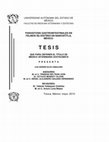
En la actualidad un gran número de poblaciones de animales en vida libre se encuentran en alarman... more En la actualidad un gran número de poblaciones de animales en vida libre se encuentran en alarmante status de conservación, debido principalmente a actividades antropogénicas (fragmentación/destrucción de hábitat y caza ilegal). Es esencial conocer sus condiciones naturales de vida e interacciones con los demás integrantes de sus ecosistemas, para así poder conservar dichas poblaciones. Se sabe que el parasitismo es una interacción reguladora de poblaciones de vida libre, de ahí la importancia de su estudio. Dentro de la Reserva Natural Sierra de Nanchititla (RNSN) habitan cinco especies de felinos silvestres (Leopardus pardalis, Leopardus wiedii, Panthera onca, Puma concolor y Puma yagouaroundi), en el presente trabajo se analizan las parasitosis gastrointestinales de dichas especies. De febrero de 2009 a enero de 2010 se colectaron 28 excretas de felinos dentro de la RNSN, posteriormente se analizaron mediante las técnicas de Faust y Sheather. Del total de muestras 17 (60.7%) presentaron evidencias de infección por los siguientes parásitos: 8 géneros del phylum Nemátoda (Aelurostrongylus, Ancylostoma, Capillaria, Physaloptera, Spirocerca, Toxocara, Trichuris y Uncinaria) 3 de los cuales se identificaron a nivel específico (A. abstrusus, S. lupi y U. stenocephala), 2 géneros del phylum Plathyhelminthes (Spirometra y Taenia) y 2 géneros del phylum Protozoo (Isospora y Giardia). Con los resultados obtenidos se contribuye al conocimiento de las enfermedades que afectan a las poblaciones de felinos silvestres, al igual que las implicaciones que éstas puedan tener en su manejo y conservación.
Conference Presentations by Adrián Silva-Caballero
Las acciones de conservación del jaguar y su hábitat en la Reserva de la Biosfera Sierra del Abra... more Las acciones de conservación del jaguar y su hábitat en la Reserva de la Biosfera Sierra del Abra-Tanchipa (RBSAT) y su área de influencia , se basan en el conocimiento sobre la ecología de la especie y análisis de amenazas. Estos esfuerzos iniciaron en 2009, desde esa fecha se ha recibido apoyo de diversas instituciones como: Deutsche Gesellschaft für Technische Zusammenarbeit (GTZ) GmbH (Cooperación Técnica Alemana), Programa de Recuperación y Repoblación de Especies en Riesgo (PROCER), Colegio de Postgraduados y diversos programas de subsidio de la Comisión Nacional de Áreas Naturales Protegidas (CONANP).
Se sabe que el parasitismo es una interacción reguladora de poblaciones de vida libre, de ahí la ... more Se sabe que el parasitismo es una interacción reguladora de poblaciones de vida libre, de ahí la importancia de su estudio. Dentro de la Reserva Natural Sierra de Nanchititla (RNSN) habitan cinco especies de felinos silvestres (Leopardus pardalis, Leopardus wiedii, Panthera onca, Puma concolor y Puma yagouaroundi), en el presente trabajo se analizan las parasitosis gastrointestinales de dichas especies.
Papers by Adrián Silva-Caballero
Mammalian Species, 2022
Mazama gouazoubira (Fischer [von Waldheim], 1814) is an ungulate commonly called gray brocket dee... more Mazama gouazoubira (Fischer [von Waldheim], 1814) is an ungulate commonly called gray brocket deer. Six morphological forms have been described, but it is currently considered as monotypic. It is a widespread medium-sized cervid, sexually dimorphic with males having antlers. The geographic distribution of M. gouazoubira extends from the southern Amazon region to northern Argentina and Uruguay and stretches from east of the dry Andean range in Argentina and Bolivia, to the Atlantic Coast. It is the most abundant species of brocket deer in South America. Habitat loss and hunting are considered the major threats and it is listed as "Least Concern" (LC) by the International Union for Conservation of Nature (IUCN).
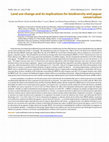
Therya
Protected areas are frequently established to prevent declines in biodiversity, but their effecti... more Protected areas are frequently established to prevent declines in biodiversity, but their effectiveness in preserving biodiversity can depend on how land outside their borders is managed. We evaluated how land use changes from 1989 to 2016 in the Reserva de la Biosfera Sierra del Abra Tanchipa (RBSAT) landscape might affect the role of the RBSAT for conservation of biodiversity, with an emphasis on conservation of jaguars, a keystone species. We estimated the rate of land use change within and surrounding the RBSAT, a 215 km2 natural reserve in San Luis Potosí, Mexico, from 1989 to 2016 using supervised classifications of satellite imagery. We also analyzed the distribution of two GPS collared male jaguars. The RBSAT and surrounding landscape became increasingly fragmented and impacted by human use over the previous ca. 30 years. The largest increases were seen in infrastructure and intensive agriculture, while the largest decreases were seen in pasture, tropical deciduous fore...
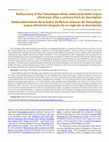
Therya notes, 2022
La liebre de flancos blancos de Tamaulipas, Lepus altamirae, fue originalmente descrita como una ... more La liebre de flancos blancos de Tamaulipas, Lepus altamirae, fue originalmente descrita como una subespecie de Lepus merriami hace más de un siglo. Varias décadas después fue reclasificada como una subespecie de la liebre de cola negra, L. californicus altamirae. A pesar de la importancia ecológica, social y económica de las liebres, existe un vacío en el conocimiento de muchas especies, tal es el caso de L. altamirae, ya que históricamente se han avistado, colectado y estudiado pocos individuos. El 13 de octubre de 2016 y el 22 de septiembre de 2021, 2 lagomorfos con pelaje pajizo-grisáceo, así como extremidades y orejas alargadas fueron fotografiados in situ durante el monitoreo de fauna silvestre en la región de la Huasteca Potosina, en el noreste de San Luis Potosí. Por su coloración, características morfológicas y distribución, se identificaron como L. altamirae. Estos son los primeros registros documentados de la especie en las tierras bajas de la Huasteca Potosina, así c...
Conservation Genetics Resources, 2012
The White nosed coati (Nasua narica) it is a highly social carnivore inhabiting mainly Neotropica... more The White nosed coati (Nasua narica) it is a highly social carnivore inhabiting mainly Neotropical forests playing an important ecological role. A technique based on 454 sequencing of a library highly enriched for microsatellite repeats was used to develop loci for Nasua narica. Twenty-four polymorphic microsatellites were developed and tested as markers in the target species. All markers were genotyped on 18 different individuals from three distinct locations. We observed medium to low genetic variation across most loci (mean number of alleles per locus = 5). Levels of expected heterozygosity across all markers was fairly low (mean H E = 0.326, range 0.05-0.49).
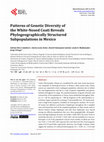
Natural Resources, 2017
Coatis (Procyonidae; Nasua) are considered the only truly social mesocarnivore mammals in Neotrop... more Coatis (Procyonidae; Nasua) are considered the only truly social mesocarnivore mammals in Neotropical forests. In Mexico, white-nosed coatis (Nasua narica) are suspected to have undergone population reduction due to habitat loss and fragmentation and led to a lack of genetic adaptability and genetic isolation throughout its range. We examined patterns of genetic diversity and connectivity of five populations of Nasua narica distributed throughout Mexico (n = 60) by sequencing an ≈ 800 bp fragment of the mitochondrial cytochrome-b gene and also by screening 12 microsatellite loci. We found moderate to high levels of genetic variability for both genetic markers. We recorded twenty-two different cytochrome-b haplotypes throughout the 5 sampled areas and found that each of the sampled population of white-nosed coatis in Mexico harbors unique haplotypes and only three haplotypes were shared among two different populations that were closer geographically. All populations had high haplotype diversity (h) (0.968 ± 0.008 (SD)) but lower levels of nucleotide diversity (π) of 0.007 ± 0.001 (SD). All microsatellite loci were polymorphic in all of the populations and the mean number of alleles per locus was 5.033 ± 1.545 (SD) with expected (H E) and observed (H O) heterozygosity values of 0.774 and 0.664, respectively. However, low Wright F statistic values suggest the existence of a reduced heterozygosity (F ST = 0.203, F IS = 0.
Mammalina Species, 2022
𝘔𝘢𝘻𝘢𝘮𝘢 𝘨𝘰𝘶𝘢𝘻𝘰𝘶𝘣𝘪𝘳𝘢 (Fischer [von Waldheim], 1814) is an ungulate commonly called gray brocket dee... more 𝘔𝘢𝘻𝘢𝘮𝘢 𝘨𝘰𝘶𝘢𝘻𝘰𝘶𝘣𝘪𝘳𝘢 (Fischer [von Waldheim], 1814) is an ungulate commonly called gray brocket deer. Six morphological forms have been described, but it is currently considered as monotypic. It is a widespread medium-sized cervid, sexually dimorphic with males having antlers. The geographic distribution of 𝘔. 𝘨𝘰𝘶𝘢𝘻𝘰𝘶𝘣𝘪𝘳𝘢 extends from the southern Amazon region to northern Argentina and Uruguay and stretches from east of the dry Andean range in Argentina and Bolivia, to the Atlantic Coast. It is the most abundant species of brocket deer in South America. Habitat loss and hunting are considered the major threats and it is listed as “Least Concern” (LC) by the International Union for Conservation of Nature (IUCN).
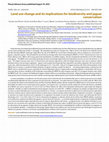
Therya, 2022
Protected areas are frequently established to prevent declines in biodiversity, but their effecti... more Protected areas are frequently established to prevent declines in biodiversity, but their effectiveness in preserving biodiversity can depend on how land outside their borders is managed. We evaluated how land use changes from 1989 to 2016 in the Reserva de la Biosfera Sierra del Abra Tanchipa (RBSAT) landscape might affect the role of the RBSAT for conservation of biodiversity, with an emphasis on conservation of jaguars, a keystone species. We estimated the rate of land use change within and surrounding the RBSAT, a 215 km² natural reserve in San Luis Potosí, Mexico, from 1989 to 2016 using supervised classifications of satellite imagery. We also analyzed the distribution of two GPS collared male jaguars. The RBSAT and surrounding landscape became increasingly fragmented and impacted by human use over the previous 𝘤𝘢. 30 years. The largest increases were seen in infrastructure and intensive agriculture, while the largest decreases were seen in pasture, tropical deciduous forest, and secondary vegetation. Jaguars were located more frequently than expected in secondary vegetation, the most common cover class, which decreased from 34.8 % of the landscape to 32.1 % by 2016. Only 23 % of jaguar locations fell within the boundaries of the RBSAT, due to increases in preferred habitat attributes of jaguars and prey outside the Reserve. Increasing fragmentation compromises the RBSAT’s role as a biodiversity reserve, especially for interior-dependent species. Fragmentation and edge habitats in combination with increasing agriculture enhance suitability of the landscape surrounding the RBSAT for prey of jaguar, and only 23 % of jaguar locations were within the RBSAT itself. This increases the likelihood of jaguar-related conflicts in surrounding communities. Regional landscape planning should include policies that incentivize practices that maintain remaining larger habitat patches and minimize the likelihood of human-wildlife conflicts.
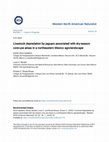
Western North American Naturalist , 2022
Predation by jaguars (𝘗𝘢𝘯𝘵𝘩𝘦𝘳𝘢 𝘰𝘯𝘤𝘢) on livestock can foster human intolerance and drive human–ja... more Predation by jaguars (𝘗𝘢𝘯𝘵𝘩𝘦𝘳𝘢 𝘰𝘯𝘤𝘢) on livestock can foster human intolerance and drive human–jaguar conflicts. Understanding distributional patterns that characterize depredation can help guide strategies to ameliorate these interactions, which is important because human conflicts are the main threat to the endangered jaguar in Mexico. We used clusters of satellite telemetry locations to evaluate spatial patterns of jaguars and jaguar predation/scavenging sites of livestock and wild ungulates in the Sierra del Abra-Tanchipa Biosphere Reserve (RBSAT) and surrounding agrolandscape of northeastern Mexico, where livestock composed 66% of the biomass of jaguar diets. Distribution of livestock sites was significantly associated with jaguar core areas (𝘪.𝘦., 50% autocorrelated KDEs) during the dry season, while wild ungulate sites were distributed similarly with respect to core areas of jaguars across both dry and wet seasons. It is unknown whether these results reflect increased chance encounters between jaguars and livestock during the dry season due to the presence of limited permanent water sources concentrating livestock (and natural prey), or due to jaguars actively seeking livestock or livestock carcasses during the dry season.
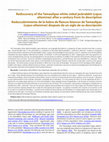
Therya Notes , 2022
The Tamaulipas white-sided jackrabbit, 𝘓𝘦𝘱𝘶𝘴 𝘢𝘭𝘵𝘢𝘮𝘪𝘳𝘢𝘦, was originally described as a subspecies ... more The Tamaulipas white-sided jackrabbit, 𝘓𝘦𝘱𝘶𝘴 𝘢𝘭𝘵𝘢𝘮𝘪𝘳𝘢𝘦, was originally described as a subspecies of 𝘓𝘦𝘱𝘶𝘴 𝘮𝘦𝘳𝘳𝘪𝘢𝘮𝘪 more than a century ago. Several decades later, it was reclassified as a subspecies of the black-tailed jackrabbit, 𝘓. 𝘤𝘢𝘭𝘪𝘧𝘰𝘳𝘯𝘪𝘤𝘶𝘴 𝘢𝘭𝘵𝘢𝘮𝘪𝘳𝘢𝘦. Despite its ecological, social and economic importance of the jackrabbits, there is a gap in the knowledge of many species, such as 𝘓. 𝘢𝘭𝘵𝘢𝘮𝘪𝘳𝘢𝘦, since historically few individuals have been sighted, collected and studied. On October 13, 2016 and September 22, 2021, 2 lagomorphs with straw-grayish fur as well as elongated limbs and ears was photographed 𝘪𝘯 𝘴𝘪𝘵𝘶 during the surveillance of wildlife in the lowlands of the Huasteca Potosina region, northeastern San Luis Potosí. Due to its coloration, morphological characteristics, and distribution, they were identified as 𝘓. 𝘢𝘭𝘵𝘢𝘮𝘪𝘳𝘢𝘦. These are the first documented records of the species in the lowlands of the Huasteca Potosina, and the first records after a century of the species description. The closest known records are located 𝘤𝘢. 98 km east in the state of Tamaulipas. The presence of the Tamaulipas white-sided jackrabbit in the region could be related to land use change. Systematic monitoring is necessary to improve knowledge about the distribution of this and other mammals in the lowlands of the Huasteca Potosina.
The Southwestern Naturalist, 2021
Two sightings of bobcat (𝘓𝘺𝘯𝘹 𝘳𝘶𝘧𝘶𝘴) were obtained in northeastern San Luis Potosí. These records... more Two sightings of bobcat (𝘓𝘺𝘯𝘹 𝘳𝘶𝘧𝘶𝘴) were obtained in northeastern San Luis Potosí. These records extend the geographic range of the species ca. 55 km south of Tamaulipas and 230 km southeast in San Luis Potosí. RESUMEN-Dos avistamientos del gato montés (𝘓𝘺𝘯𝘹 𝘳𝘶𝘧𝘶𝘴) se obtuvieron en el noreste de San Luis Potosí. Estos registros extienden la distribución geográfica de la especie ca. 55 km al sur de Tamaulipas y 230 km al sureste en San Luis Potosí.
The White nosed coati (Nasua narica) it is a highly social carnivore inhabiting mainly Neotropica... more The White nosed coati (Nasua narica) it is a highly social carnivore inhabiting mainly Neotropical forests playing an important ecological role. A technique based on 454 sequencing of a library highly enriched for microsatellite repeats was used to develop loci for Nasua narica. Twenty-four polymorphic microsatellites were developed and tested as markers in the target species. All markers were genotyped on 18 different individuals from three distinct locations. We observed medium to low genetic variation across most loci (mean number of alleles per locus = 5). Levels of expected heterozygosity across all markers was fairly low (mean H E = 0.326, range 0.05-0.49).
Therya, 2014
Introduction: Chromatic aberrations happen infrequently in mammals, usually as a result of the ex... more Introduction: Chromatic aberrations happen infrequently in mammals, usually as a result of the expression of a recessive gene. Leucism is the partial or total loss of pigmentation; this condition is the result of genetic mutations. This manuscript is the first report of leucistic individuals of White-nosed coati Nasua narica in Mexico. Methods: In September-October 2012, in the course of a faunal survey in the Yucatán Peninsula two atypical White-nosed coatis Nasua narica (Linnaeus 1766) was sighted and photographed in two different localities:
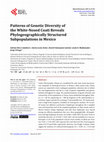
Natural Resources, 2017
Coatis (Procyonidae; 𝘕𝘢𝘴𝘶𝘢) are considered the only truly social mesocarnivore mammals in Neotrop... more Coatis (Procyonidae; 𝘕𝘢𝘴𝘶𝘢) are considered the only truly social mesocarnivore mammals in Neotropical forests. In Mexico, white-nosed coatis (𝘕𝘢𝘴𝘶𝘢 𝘯𝘢𝘳𝘪𝘤𝘢) are suspected to have undergone population reduction due to habitat loss and fragmentation and led to a lack of genetic adaptability and genetic isolation throughout its range. We examined patterns of genetic diversity and connectivity of five populations of Nasua narica distributed throughout Mexico (n = 60) by sequencing an ≈ 800 bp fragment of the mitochondrial cytochrome-
b gene and also by screening 12 microsatellite loci. We found moderate
to high levels of genetic variability for both genetic markers. We recorded
twenty-two different cytochrome-b haplotypes throughout the 5 sampled
areas and found that each of the sampled population of white-nosed coatis in Mexico harbors unique haplotypes and only three haplotypes were shared among two different populations that were closer geographically. All populations had high haplotype diversity (h) (0.968 ± 0.008 (SD)) but lower levels of nucleotide diversity (π) of 0.007 ± 0.001 (SD). All microsatellite loci were polymorphic in all of the populations and the mean number of alleles per locus was 5.033 ± 1.545 (SD) with expected (HE) and observed (HO) heterozygosity values of 0.774 and 0.664, respectively. However, low Wright F statistic values suggest the existence of a reduced heterozygosity (Fst = 0.203, Fis = 0.134 and Fit = 0.310). Significant differences between the five populations confirmed isolation by distance, which suggests genetic structure among five subpopulations.
Therya, 2014
Las aberraciones cromáticas ocurren en mamíferos con poca frecuencia. El leucismo es la pérdida p... more Las aberraciones cromáticas ocurren en mamíferos con poca frecuencia. El leucismo es la pérdida parcial o total de la pigmentación, dicha condición deriva de mutaciones genéticas. En este trabajo se presenta el primer registro de individuos leucísticos del coatí de nariz blanca Nasua narica en México.










Uploads
Thesis Chapters by Adrián Silva-Caballero
Se analizaron la variabilidad y estructura genética del N. narica en cinco poblaciones de México (Parque Museo de La Venta, Parque Nacional El Tepozteco, Puerto Morelos, Punta Raza y Reserva de la Biosfera de Chamela-Cuixmala) mediante el uso de marcadores moleculares, 12 microsatélites específicos y un fragmento del gen de citocromo b. Los resultados mostraron niveles de moderados a altos en los indicadores de variabilidad genética para ambos marcadores genéticos. La heterocigosidad esperada (HE) fue de 0.664, mientras que la heterocigosidad observada (HO) fue de 0.774. La mayoría de los microsatélites se encontraron en equilibrio de Hardy-Weinberg. Todos los loci fueron polimórficos en las cinco poblaciones y el promedio de alelos por locus fue de 5.033 ± 1.794 (DE). La diversidad haplotípica (h) para las poblaciones en conjunto fue 0.968 ± 0.008 (DE) y la diversidad nucleotídica (π) de 0.007 ± 0.001 (DE).
Se registraron 22 haplotipos distintos, la mayoría fueron específicos de una de las áreas muestreadas, sólo tres se compartieron entre las distintas poblaciones. Se encontraron diferencias significativas entre las poblaciones de la Costa del Pacífico (Punta Raza y Reserva de la Biosfera Chamela-Cuixmala), las del centro (Parque Nacional El Tepozteco) y sureste del país (Parque Museo La Venta y Puerto Morelos), corroborando que el aislamiento genético tiene un efecto significativo en ésta especie resultando en una estructura genética compuesta por cinco diferentes subpoblaciones.
Conference Presentations by Adrián Silva-Caballero
Papers by Adrián Silva-Caballero
b gene and also by screening 12 microsatellite loci. We found moderate
to high levels of genetic variability for both genetic markers. We recorded
twenty-two different cytochrome-b haplotypes throughout the 5 sampled
areas and found that each of the sampled population of white-nosed coatis in Mexico harbors unique haplotypes and only three haplotypes were shared among two different populations that were closer geographically. All populations had high haplotype diversity (h) (0.968 ± 0.008 (SD)) but lower levels of nucleotide diversity (π) of 0.007 ± 0.001 (SD). All microsatellite loci were polymorphic in all of the populations and the mean number of alleles per locus was 5.033 ± 1.545 (SD) with expected (HE) and observed (HO) heterozygosity values of 0.774 and 0.664, respectively. However, low Wright F statistic values suggest the existence of a reduced heterozygosity (Fst = 0.203, Fis = 0.134 and Fit = 0.310). Significant differences between the five populations confirmed isolation by distance, which suggests genetic structure among five subpopulations.
Se analizaron la variabilidad y estructura genética del N. narica en cinco poblaciones de México (Parque Museo de La Venta, Parque Nacional El Tepozteco, Puerto Morelos, Punta Raza y Reserva de la Biosfera de Chamela-Cuixmala) mediante el uso de marcadores moleculares, 12 microsatélites específicos y un fragmento del gen de citocromo b. Los resultados mostraron niveles de moderados a altos en los indicadores de variabilidad genética para ambos marcadores genéticos. La heterocigosidad esperada (HE) fue de 0.664, mientras que la heterocigosidad observada (HO) fue de 0.774. La mayoría de los microsatélites se encontraron en equilibrio de Hardy-Weinberg. Todos los loci fueron polimórficos en las cinco poblaciones y el promedio de alelos por locus fue de 5.033 ± 1.794 (DE). La diversidad haplotípica (h) para las poblaciones en conjunto fue 0.968 ± 0.008 (DE) y la diversidad nucleotídica (π) de 0.007 ± 0.001 (DE).
Se registraron 22 haplotipos distintos, la mayoría fueron específicos de una de las áreas muestreadas, sólo tres se compartieron entre las distintas poblaciones. Se encontraron diferencias significativas entre las poblaciones de la Costa del Pacífico (Punta Raza y Reserva de la Biosfera Chamela-Cuixmala), las del centro (Parque Nacional El Tepozteco) y sureste del país (Parque Museo La Venta y Puerto Morelos), corroborando que el aislamiento genético tiene un efecto significativo en ésta especie resultando en una estructura genética compuesta por cinco diferentes subpoblaciones.
b gene and also by screening 12 microsatellite loci. We found moderate
to high levels of genetic variability for both genetic markers. We recorded
twenty-two different cytochrome-b haplotypes throughout the 5 sampled
areas and found that each of the sampled population of white-nosed coatis in Mexico harbors unique haplotypes and only three haplotypes were shared among two different populations that were closer geographically. All populations had high haplotype diversity (h) (0.968 ± 0.008 (SD)) but lower levels of nucleotide diversity (π) of 0.007 ± 0.001 (SD). All microsatellite loci were polymorphic in all of the populations and the mean number of alleles per locus was 5.033 ± 1.545 (SD) with expected (HE) and observed (HO) heterozygosity values of 0.774 and 0.664, respectively. However, low Wright F statistic values suggest the existence of a reduced heterozygosity (Fst = 0.203, Fis = 0.134 and Fit = 0.310). Significant differences between the five populations confirmed isolation by distance, which suggests genetic structure among five subpopulations.